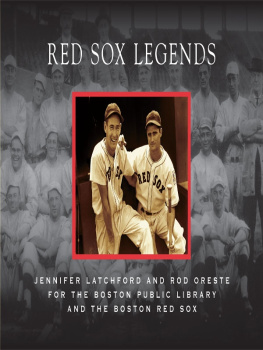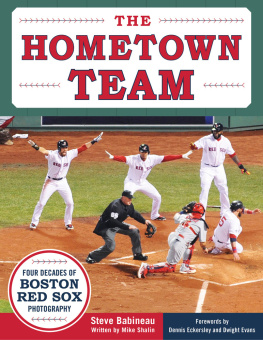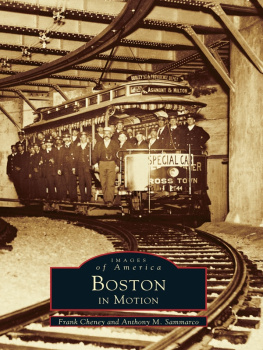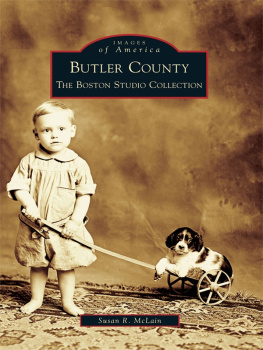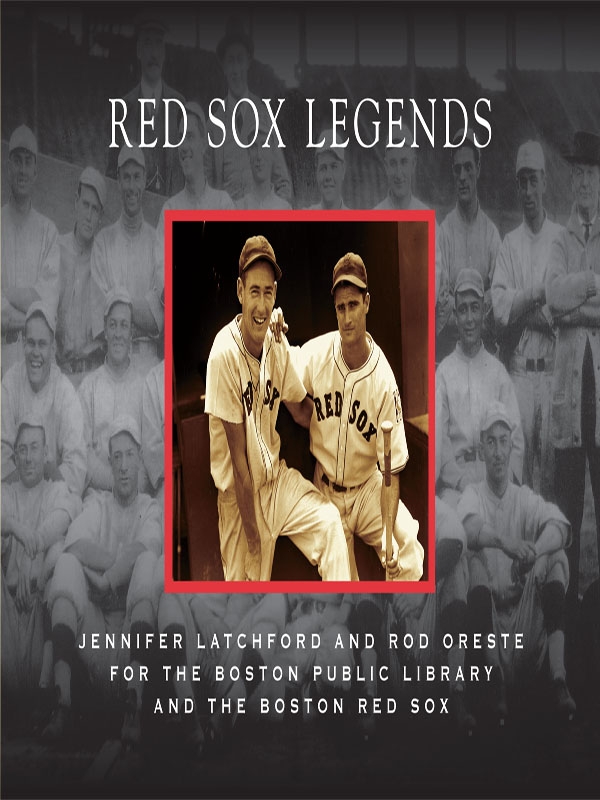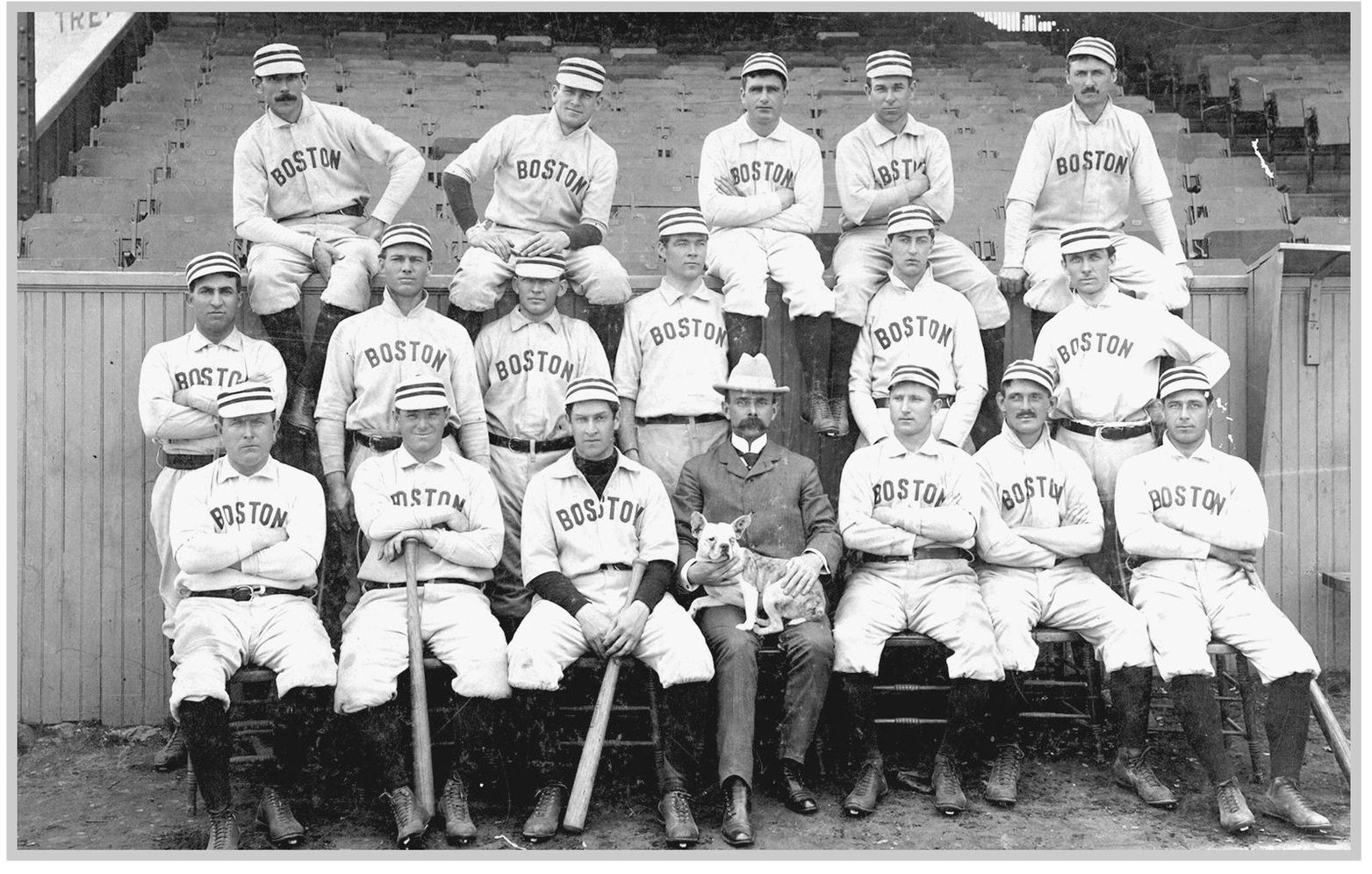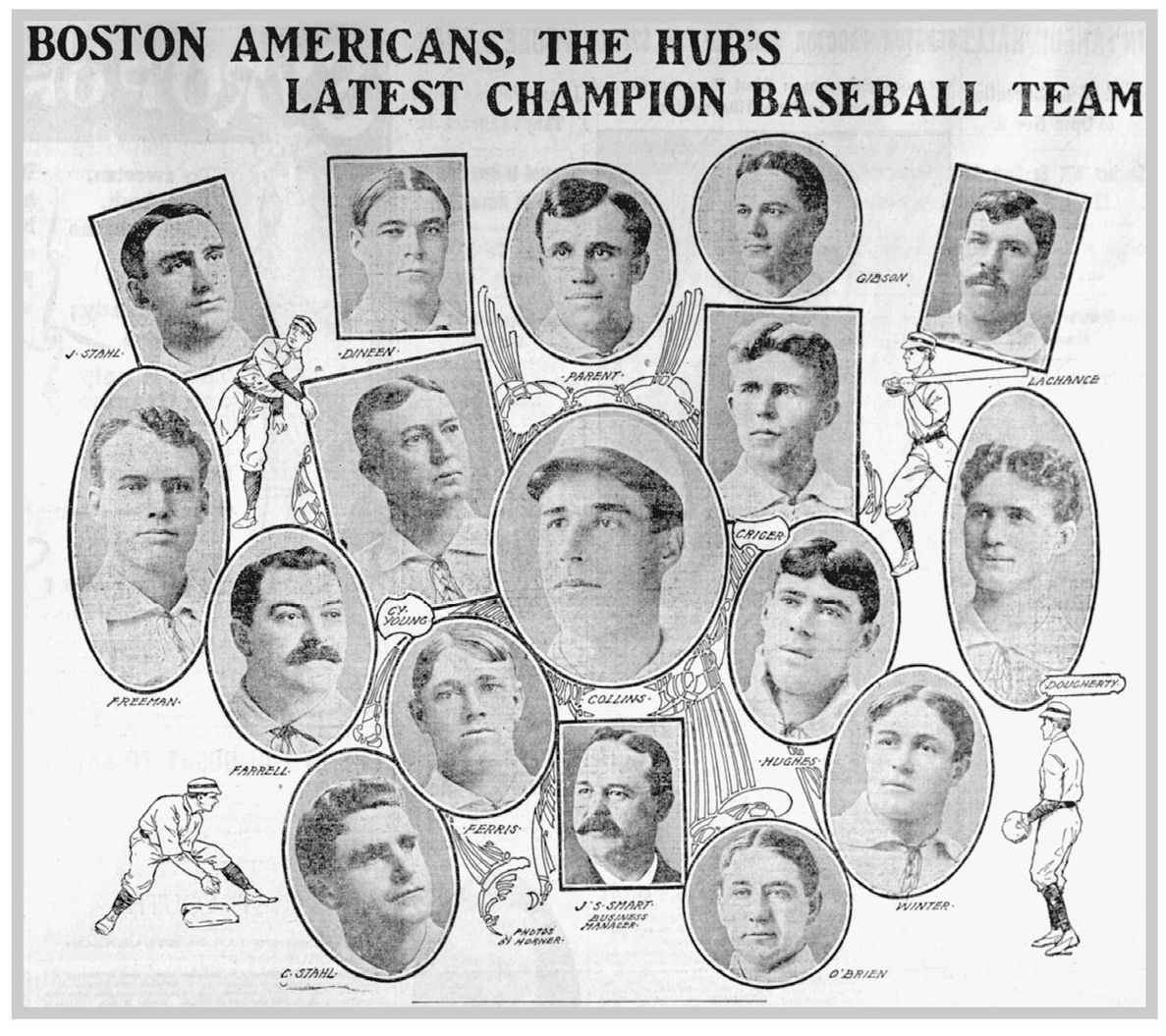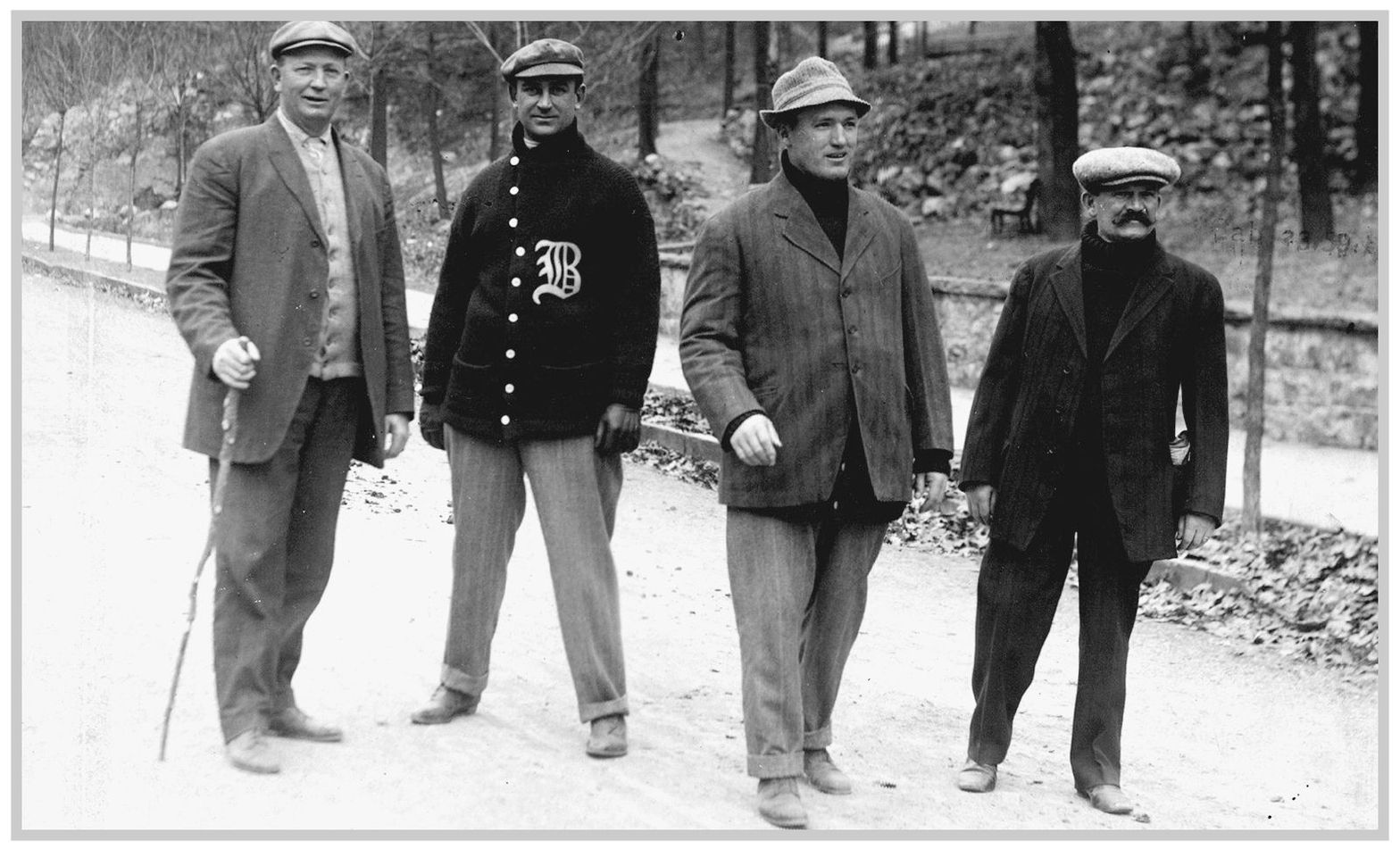Find more books like this at
www.imagesofamerica.com
Search for your hometown history, your old stomping grounds, and even your favorite sports team.
The Boston Red Stockings were charter members of the National Association of Baseball (later changed to the National League). They were quite successful until the opening of Bostons entry in the competing American League, the Boston Americans. Shown here is the 1900 team, called the Boston Beaneaters. In 1900, this team went 66-72, had a winning percentage under .500, and finished fourth in the league. Many of the players pictured went on to play for the Boston Americans when they were offered better contracts to play in the new league. The Beaneaters (later the Braves) suffered mightily over the ensuing years, until 1914 when they stunned the league by going from last place to first place in less than two months and winning the World Series. Pictured from left to right are the following: (first row) unidentified, Billy Hamilton (outfielder), Kid Nichols (pitcher), Frank Selee (manager) with dog, Herman Long (shortstop), Fred Tenney (first baseman), and Jimmy Collins (third baseman); (second row) unidentified, Buck Freeman, unidentified, Bill Dinneen (pitcher), Ted Lewis (pitcher), and unidentified; (third row) Bobby Lowe (second baseman), unidentified, Chick Stahl (outfielder), Hugh Duffy (outfielder), and unidentified.
Elmer Chickering photograph, the McGreevey Collection of the Boston Public Library, 1900
Boston was one of the original eight teams that began the American League in 1901. The team won the first World Series in 1903 and was known as the Boston Americans. The legends of that team include Cy Young, Jimmy Collins, and Chick Stahl (the last two stolen from the local National League team, the Boston Beaneaters). Young, with a career that spanned two decades and produced 511 wins, is generally regarded as one of the finest pitchers in the history of the game. Stahl contributed to the 1903 World Series victory by hitting three triples. The Boston Americans played at the old Huntington Avenue Grounds, on the current campus of Northeastern University, prior to their move to Fenway Park in 1912. In 1903, Boston was already crazy for baseball, and the Huntington Avenue Grounds were often packed to capacity. It was a more permissive environment than today. In fact, prior to the third game of the 1903 World Series, fans were allowed to walk on the field. This team photograph ran in a local newspaper after Boston won the 1903 World Series.
Published by the Boston Globe, from the Boston Newspaper Archive of the Boston Public Library, September 1903
Michael McGreevey, often known as Nuf Ced McGreevey because of his way of ending arguments, was the penultimate Boston baseball fan. Not only was he the head of the Royal Rooters, but he was also the owner of a local tavern aptly named Third Base because it was the last place one stopped before one went home. His tavern was decorated with baseball memorabilia of Bostons hometown heroes, much of which now resides in the collections of the Boston Public Library. The Royal Rooters showed their devotion by cheering, chanting, and sometimes razzing the opposing team. In fact, it was this group that introduced the local crowd to Tessie, a hit song from a Broadway musical. The song was meant to taunt and tease the opposing team but became more of a rallying cry as the years wore on. Recently the song inspired a new version recorded by the Dropkick Murphys that is often played at Fenway Park. Nuf Ced (far right) is shown here with, from left to right, newly retired Cy Young (who was the ERA champion in 1901, pitched the only perfect game in Red Sox history on May 5, 1904, and pitched a no-hitter in June 1908), player-manager Jake Stahl (who was the 1910 home run champion with 10 home runs and had 105 wins in the 1912 season), and catcher Bill Carrigan (who had 101 wins in the 1915 season as the manager) in Hot Springs, Arkansas, during spring training.
Published by the Arlington Studios, Hot Springs, Arkansas, from the McGreevey Collection of the Boston Public Library, c. 1910
In their first season in the newly built Fenway Park, the Red Sox took home the world championship for the second time since the American Leagues inception in 1901. Their new home was recognized for its innovations, including the net installed behind the catcher to prevent errant balls from entering the stands. The park itself opened in April 1912 and garnered rave reviews, as did the team. Many of the legends of this teamBill Carrigan, Harry Hooper, Larry Gardner, Tris Speaker, Smokey Joe Wood, Jimmy Collins, Jake Stahlare household names to Red Sox fans. One player depicted is Bill Carrigan, who was appropriately nicknamed Rough. The rugged and tough catcher had a bulldogs personality and an uncompromising attitude that earned him immediate respect on the team. Carrigan caught for the Red Sox for 10 seasons, from 1906 to 1916, and was a player-manager for the final three seasons. After finishing second in 1914, Carrigan managed to lead his team to two consecutive World Series championships in 1915 and 1916. After his second World Series title in as many years and at the pinnacle of his baseball career, the 33-year-old Carrigan decided to call it quits. He is still the only Red Sox manager in history to ever win back-to-back World Series titles. This postcard shows the 1912 team with the names of the players added.
The Photo Art Shop, from the Sports Collection of the Boston Public Library, 1912
In 1912, Tris Speaker was the center fielder. Duffy Lewis, the left fielder, called him the King of the Outfield as he would always call out you take it or I got it on fly balls. Speaker ranks among Red Soxs all-time fielding leaders for outfield assists and double plays. His extraordinary speed not only made him a threat on the base paths but also allowed him to play a very shallow center field in order to rob opposing hitters of base hits. Speaker was also blessed with a rifle arm and holds the record for American League runners thrown out (35) in a season, which he accomplished twice, in 1909 and 1912. Left fielder Lewis burst onto the baseball scene in 1910 and became an instant star as he hit .283 and led the Red Sox with 29 doubles in his rookie year. Throughout his entire Red Sox career, his offensive production was always consistent, but it was his spectacular defense that made him famous. When Fenway Park was built in 1912 with its unusual 25-foot-high left field fence, it was supported by a 10-foot-high dirt embankment in left field. The hill sloped at a 45-degree angle and caused havoc for many opposing outfielders attempting to field a long fly ball. But Lewis was so adept at climbing the hill to catch flies that it became known as Duffys Cliff. On a hard-hit fly ball, Lewis would scamper up the hill, spot the ball, and then decide whether to go right, left, or run back down for the catch. Relay throws from the slope often sent him tumbling down to the bottom. They made a mountain goat out of me, Lewis once said. Harry Hooper, Tris Speaker, and Duffy Lewis (pictured from left to right) comprised one of the greatest all-around outfield trios and were known as the Million Dollar Outfield. They are shown here at an old-timers game in 1939.

